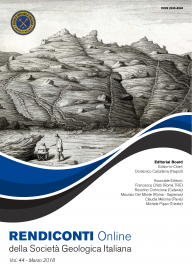
The "Subiaco stone" and the early studies on the carbonate successions of the Upper Aniene Valley
Simone Fabbi (1,3), Riccardo Cestari (2) & Rita Maria Pichezzi (3)
(1) Dipartimento di Scienze della Terra, "Sapienza" Università di Roma, piazzale A. Moro, 5, 00185 Rome, Italy.
(2) StrataGeoResearch Spin-off, Università G. d'Annunzio Chieti-Pescara, via dei Vestini, 32, 66013 Chieti, Italy.
(3) Servizio Geologico d'Italia - ISPRA, via V. Brancati 48, 00144 Roma, Italy.
Corresponding author e-mail: simone.fabbi@uniroma1.it.
DOI: https://doi.org/10.3301/ROL.2018.03
Volume: 44/2018
Pages: 15-21
Abstract
The carbonate succession cropping out in the Upper Aniene Valley was studied since the last decade of the XIX century. Before, only generic mentions to the fossil content of carbonate rocks were made. Since the year 1890 the interest of geologists for this part of Italy grew up, mostly due to the finding of an abundant rudist fauna from the Monte Affilano quarry (Central Apennines), where a high quality and very versatile lithoid material known as "Subiaco stone" was extracted; the remarkable well preserved rudist bivalves found in the quarry made possible the establishment of the new genus Sabinia and four species. Starting from this locality, the whole Mesozoic carbonate succession was then studied, leading in only a few years to the definition of an almost continue Upper Triassic/Upper Cretaceous succession. Subsequently, between 1920 and 1930, also the lack of Paleogene rocks was noticed, thus completing the typical picture of
a Meso-Cenozoic carbonate succession including a wide Paleogenic hiatus; the first geological map of the area was therefore published only in 1939.
Keywords
Get Full Text